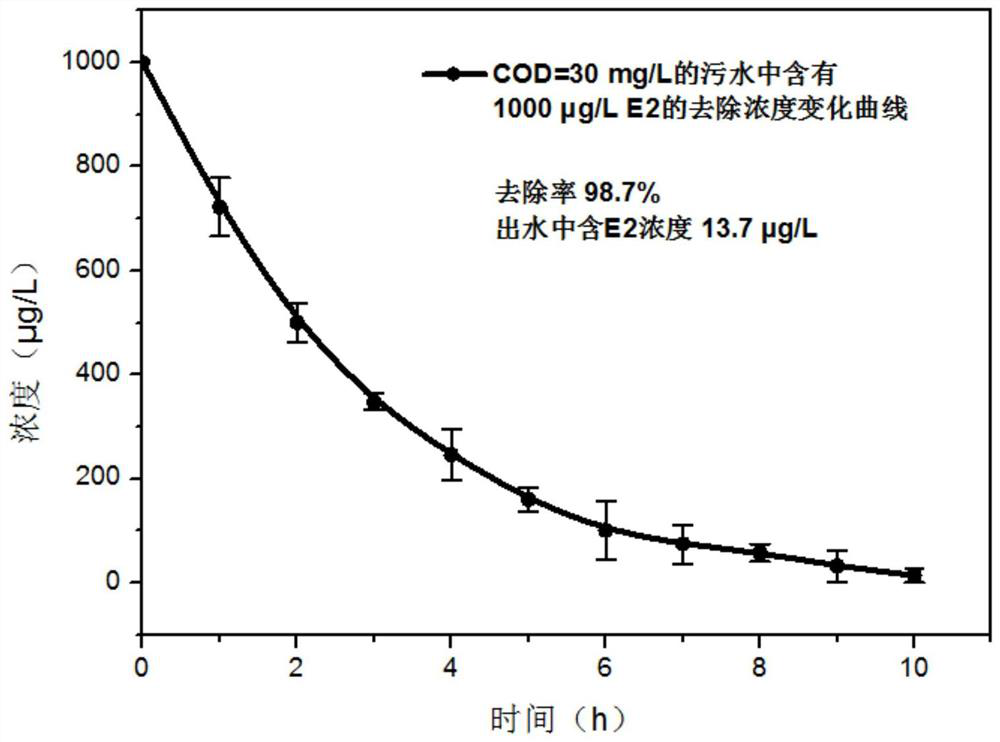Selective Photoelectrocatalytic Removal of Low-concentration 17β-estradiol in Coexisting Systems
A photoelectric catalysis and estradiol technology, applied in chemical instruments and methods, physical/chemical process catalysts, chemical/physical processes, etc., to achieve high selectivity, good stability, and simple preparation
- Summary
- Abstract
- Description
- Claims
- Application Information
AI Technical Summary
Problems solved by technology
Method used
Image
Examples
Embodiment 1
[0025] A 17β-estradiol-selective photoanode comprising one-dimensional single-crystal TiO 2 Nanorod electrodes, and imprinted one-dimensional single-crystal TiO 2 The 17β-estradiol shape-selective catalytic site on the nanorod electrode surface was fabricated by the following steps:
[0026] (1) Weigh concentrated hydrochloric acid and mix with water, then dropwise add tetrabutyl titanate, stir at 450rpm for 1h, add template molecule 17β-estradiol, concentrated hydrochloric acid, water, tetrabutyl titanate and 17β-estradiol The volume ratio of the added amount of alcohol is 7.5:7.5:0.35:0.05, and the concentration of concentrated hydrochloric acid is 37wt% to obtain the precursor solution;
[0027] (2) Transfer the precursor solution to a sealed reactor, immerse the conductive side of the pretreated FTO into the solution, and react at 150°C for 4 hours;
[0028] (3) After the reaction is completed, take out the product, rinse with deionized water, take out the surface residu...
Embodiment 2
[0030] One-dimensional single crystal TiO with 17β-estradiol shape-selective sites prepared in Example 1 2 The nanorod electrode was used as the working electrode, and the electrode area was 9 cm 2 , the saturated calomel electrode is the reference electrode, and the platinum electrode is the counter electrode. A 17β-estradiol solution with a concentration of 1 mg / L was prepared with pure water, and the solutions contained 1 mg / L humic acid, 1 mg / L atrazine, 1 mg / L bisphenol A and other co-existing pollutants respectively. Photoelectrochemical oxidative degradation was carried out under UV irradiation and a bias voltage of 0.6 V. During the treatment, sodium sulfate electrolyte was added to make its concentration 0.1 mol / L. After 10 hours of degradation, the removal rate of 17β-estradiol was 99.1%, and the concentration of E2 in the treated water was 9 μg / L. This shows that for low concentrations of 17β-estradiol in the water system, the photoelectric oxidation technology c...
Embodiment 3
[0032] The photoanode with the selective oxidation function of 17β-estradiol prepared in Example 1 was used as the working electrode, and the electrode area was 9cm 2, the saturated calomel electrode is the reference electrode, and the platinum electrode is the counter electrode. Under the irradiation of ultraviolet light and the bias voltage of 0.6V, the photoelectrochemistry of 1mg / L 17β-estradiol solution contained in COD=30mg / L sewage was carried out. Oxidative degradation. During the treatment, sodium sulfate electrolyte was added to make its concentration 0.1 mol / L. After being degraded for 10 hours, the removal rate of 17β-estradiol was 98.7%, and the concentration of E2 in the treated water was 13.7 μg / L, such as figure 1 shown. This example shows that for low-concentration 17β-estradiol in an actual complex water system with a COD of 30 mg / L, without pretreatment and separation, the photoelectric oxidation technology can directly achieve the purpose of preferentiall...
PUM
| Property | Measurement | Unit |
|---|---|---|
| area | aaaaa | aaaaa |
Abstract
Description
Claims
Application Information
 Login to View More
Login to View More - R&D
- Intellectual Property
- Life Sciences
- Materials
- Tech Scout
- Unparalleled Data Quality
- Higher Quality Content
- 60% Fewer Hallucinations
Browse by: Latest US Patents, China's latest patents, Technical Efficacy Thesaurus, Application Domain, Technology Topic, Popular Technical Reports.
© 2025 PatSnap. All rights reserved.Legal|Privacy policy|Modern Slavery Act Transparency Statement|Sitemap|About US| Contact US: help@patsnap.com

